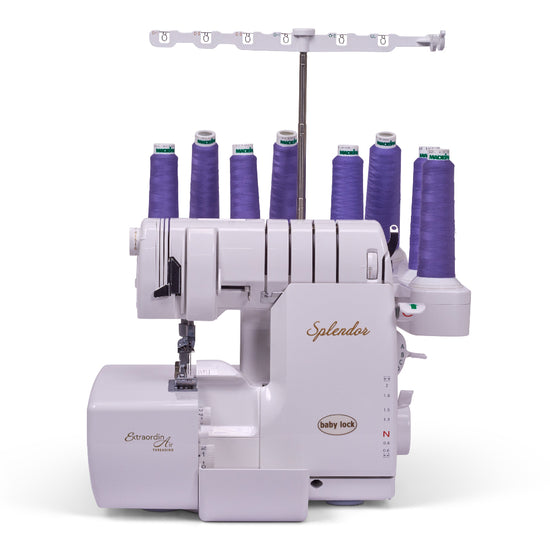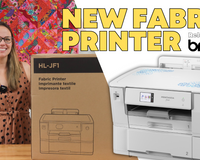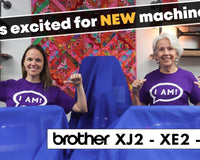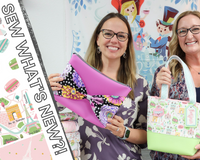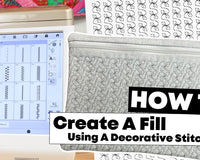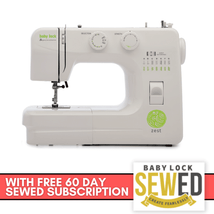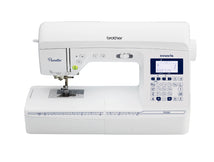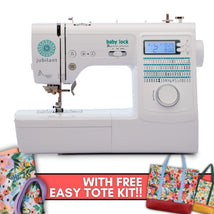
Ribbons and Pinwheels QOV quilt, 60” x 72”

Renata’s Tablerunner 18” x 36”
The design of this quilt and tablerunner start with the same ruler (BasiX), and then I added a few other techniques to each project that I’d like to tell you about.
BasiX ruler
The BasiX ruler comes in a package with TWO free patterns, and those are the two patterns I used to make my quilt and tablerunner. Its really a great value because usually one quilt pattern is $8-$10, but we get 2 patterns AND the ruler for only $15.


Tip: When you take the ruler out of the package, you’ll notice it’s smooth on both sides. I like these ruler grips to use on the back of the ruler to keep it from slipping on the fabric.
We start this process with three 2.5” strips. If you have a jelly roll you’re hankering to use, this is a good time. Otherwise, cut your strips with the Accuquilt strip die (or this die) or your rotary cutter.

Tip: You really need make sure you’ve got a good handle on that scant quarter inch seam here. And that scant seam depends on: thickness of fabric, thickness of thread, how well you press flat. Do yourself a favor and test. Sew 3 strips together just a few inches and measure across after pressing. You should get 6.5” across. If not, adjust!
Here is a great video tutorial that explains how to use the BasiX ruler really well.
Here’s a link to purchase the BasiX Ruler and the great lazy susan cutting mat I like so much. This rotating mat allows you to rotate your cutting project without moving your cutting project (or catch yourself rotary cutting upside down and backward!).
Flange binding

Wow! This flange binding LOOKS hard, but really its not! I really like this video from MSQC where Jenny explains it very well. I’m so glad I finally sat down and watched the video. I’ll never make binding any other way again! Well, unless I have a pieced border where the flange might chop off my pretty triangle points.
Jenny (MSQC) likes to cut her regular binding 2.5” wide, but I much prefer 2.25” wide. I like the finished binding to be ¼” wide to just cover up the last seam. I’m giving you measurements for both.
For 2.5” wide binding, cut your fabric
- Flange fabric: 1.75” wide
- Binding (outside) fabric: 1.5” wide
For 2.25” wide binding, cut your fabric
- Flange fabric: 1.50” wide
- Binding (outside) fabric: 1.25” wide
Tip You do NOT need to press the binding in half lengthwise. I don’t. But you can if you want.
Triangulations
Here is my EQ8 computer design of the entire quilt, including my own border design

You may notice that the pieced border is simply 3” blue squares, plus a bunch of 3” half square triangles (HST) in 2 different combinations: red/blue and red/white.
Tip: if you look carefully at the diagram above, you’ll some 3” white or blue squares that are adjacent to each other. In my scrappy version I substituted one
6” rectangle for 2 adjacent 3” squares. So I cut those pieces 6.5” x 3.5”. Of course your version doesn’t have to be scrappy, you can just use all one white, all one red and all one blue fabric.
I have a GREAT way to make lots of HST with no trimming. I know, right? I love a product called Triangulations by Brenda Henning. If you’ve ever heard of Thangles, it’s a similar product, except YOU print out the papers you need in the size you need.
Triangulations is a CD that contains several PDF files. Each file makes a different basic block, either HST, QST (quarter square triangles) or Flying Geese. You print the page with the size block you want. In this case, I print page 30, which is 3” finished HST for my quilt.
Here’s what page 30 looks like

Tip: when you stack the fabric, start with the dark fabric right side up, then the light fabric right side down, then finally the paper right side up. This means your seam allowances will automatically be pressed toward the dark side.
Here is a great video tutorial on using Triangulations.
If you want to ‘try before you buy’, here are some free pages to try out Triangulations.
I really love printing out the size I need, the amount I need, at the time I want them. Too often with Thangles I would buy too many or too few for the project at hand. I just love Triangulations!!
Oh, and I do not recommend printing these on regular copy paper. Its too think and will pull your stitches out. I like very thin newsprint that can be found online.


